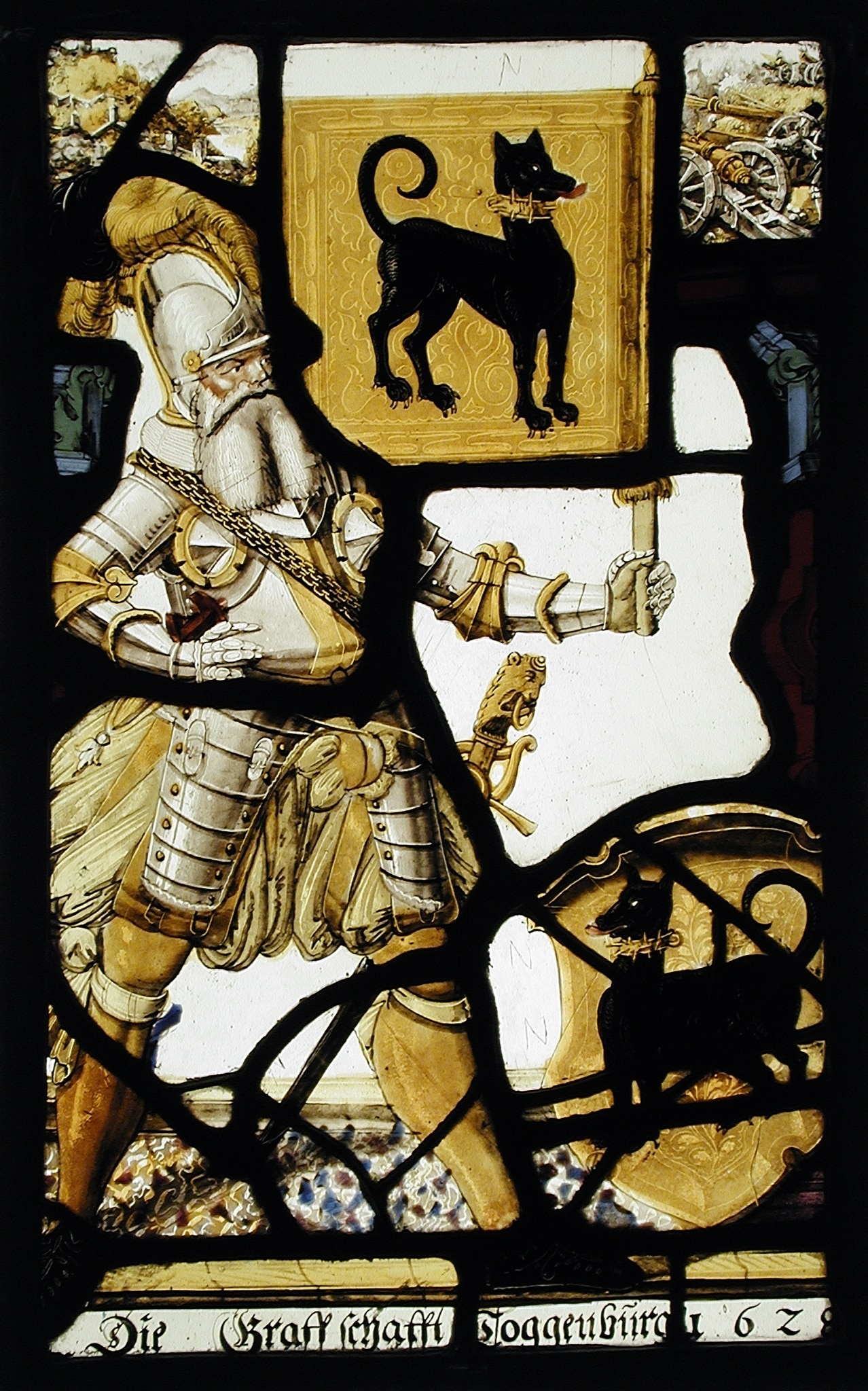The proud solitary standard bearer should not be understood as a portrayal of the Count of Toggenburg himself, but as a personification of Toggenburg's integrity and ability to defend its borders. The figure's noble deportment and its insertion into the immediate foreground directly over the inscription are comparable to other early seventeenth century images of commanders, who are intentionally enlarged to go beyond their architectural setting.
The Great Dane, known as Dogge in German, makes a kind of pun on the word Toggen, in keeping with the traditional Swiss custom of alliteration in the selection of heraldic animals. Basel, for example, has basilisks as supporters. The black silhouette of the hound and its attributes of spiked gold collar, long, curving claws and red tongue extended have undergone few changes in two hundred years. An important early image of the Dogge has been preserved on the late fifteenth-century funerary banner of Graf Friedrich VII of Toggenburg. Originating from the abbey church of Rüti, the banner of painted silk measures 93 by 87 centimeters and is ascribed to the end of the fifteenth century (Zurich, Swiss National Museum, KZ 5720; Bruckner, 1942, pp. 42, 125, color pl. 16; Schwarz, 1948, pp. 215–16, fig. 66).
The importance of Swiss banners in military engagement and display continues a long tradition in medieval Europe. See studies of banners and communal display through the fourteenth century by Robert W. Jones (Jones, 2010, pp. 57–67). The position of the dog on the banner in reverse of that of the shield was a common occurrence in sixteenth-century Renaissance armorials, and it alternates accordingly in the few known seventeenth-century territorial armorials made for Toggenburg. In this case, the choice of having the hound and figure facing the same direction might be explained by the group of cannons being fired in the right half of the miniature scene above. It seems that the Dogge functions as an emblem come to life; in contempt of the attack, it confronts the cannon blasts before the bastions of the hilltop fortress in the other half of the miniature.
In relation to other Swiss territories and cantons, the former Earldom of Toggenburg in the Thur valley, eastern Switzerland, was late in representing itself through fashionable armorials. See Uta Bergmann for background (Bergmann, 2019). Following the first municipal commissions recorded in 1551, the inhabitants of Toggenburg set forth the customary exchange of armorial gifts which continued until 1780. In his introduction to the Toggenburg glass, Paul Boesch set the purpose of the windows as luxury gifts, noting that the earliest panels were gifts of the Duchy itself, the Landvogt, or the Abbess of Magdenau (Boesch, 1935, pp. 5–6). The earliest extant Toggenburg panel known to Boesch is a work, dated 1547, showing a standard bearer and a halberdier framing the shield of the Grafschaft (Schlossmuseum Vaduz, Liechtenstein, from the collection of A. Angst (Boesch, 1935, p. 17, no. 1, frontispiece). He notes that Hans Lehmann associated it with Carl von Egeri of Zurich, as the work follows Egeri’s variation of the Renaissance type showing one or two military figures framed by architecture who display single or repeated arms against a damascene ground. By the seventeenth century, the damascene has been substituted for a white or yellow background to allow greater light to enter the room, but mainly to show off the preferred grisaille technique of the uniform and architectural frame. Still, the emblematic idea of personifying a region through an image of military valor remained unchanged. In total, Boesch identified fifteen such representations dating to the sixteenth century and five panels of territorial standard bearers in the seventeenth (Boesch, 1935, pp. 30, 42, 54, 67; cat. nos. 54 and 55 dated 1605; 98 dated 1618, fig. 12; 139 dated 1634; 175 dated 1673, fig. 24). Among the works listed, an entry bearing the date of 1628 is not mentioned.
A comparison can be made with a panel from ten years earlier by Hans Ulrich Fisch the Elder of Aarau (1583–1647) showing a Toggenburg standard bearer, dated 1618 (Toggenburger Museum in Lichtensteig, canton St. Gallen; Boesch, 1935, p. 42, no. 98, fig. 12). Both show the same use of multi-hued enamel flooring. The shape of the lion-headed sword hilt on the standard bearer's uniform is repeated in the Lichtensteig panel, which also has the same type of border framing the Great Dane on the banner. In the 1618 panel, the scenes above are those of the martyrdom of St. Sebastian on the right and the flagellation of Christ on the left. Quite similar is a panel in St. Gallen, dated 1605 where, as in the Los Angeles work, the dogs face opposite directions (Egli, 1927, no. 100, pp. 51–52). The narrative scenes at the top of the St. Gallen panel, St. Sebastian and the Flagellation, repeat those of Lichtensteig.
Cited in:
LACMA Quarterly, 1945,, pp. 5–10.
Normile, 1946, pp. 43–44.
Hayward, 1989, p.78.
Raguin, 2024, vol. 1, pp. 231–34.
